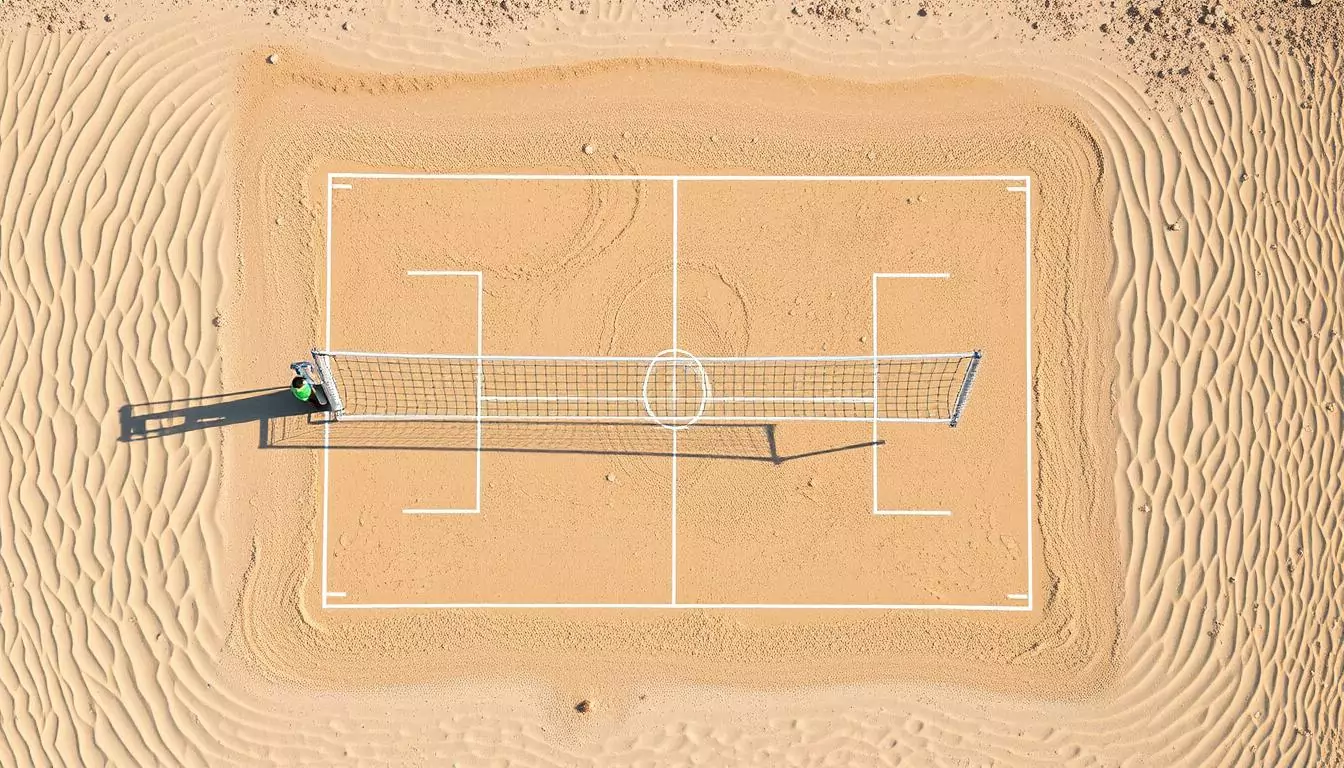As a passionate volleyball player, I’ve seen how mastering serve receive can change the game. It’s the quiet hero that shapes every rally. A strong serve receive makes your team’s offense stronger, boosts your confidence, and lets you control the match.
In this guide, I’m excited to share secrets to becoming a serve receive expert. Whether you’re new or experienced, these tips will take your game to the next level.
Key Takeaways
- Understand the critical role of serve receive in volleyball’s game dynamics.
- Master the fundamentals of effective serve receive technique, including body positioning, hand placement, and footwork.
- Develop strategies for handling different types of serves, from float serves to topspin and jump serves.
- Learn mental preparation techniques to stay focused and confident under pressure.
- Discover drills and exercises to continuously improve your serve receive skills.
Understanding the Importance of Serve Receive
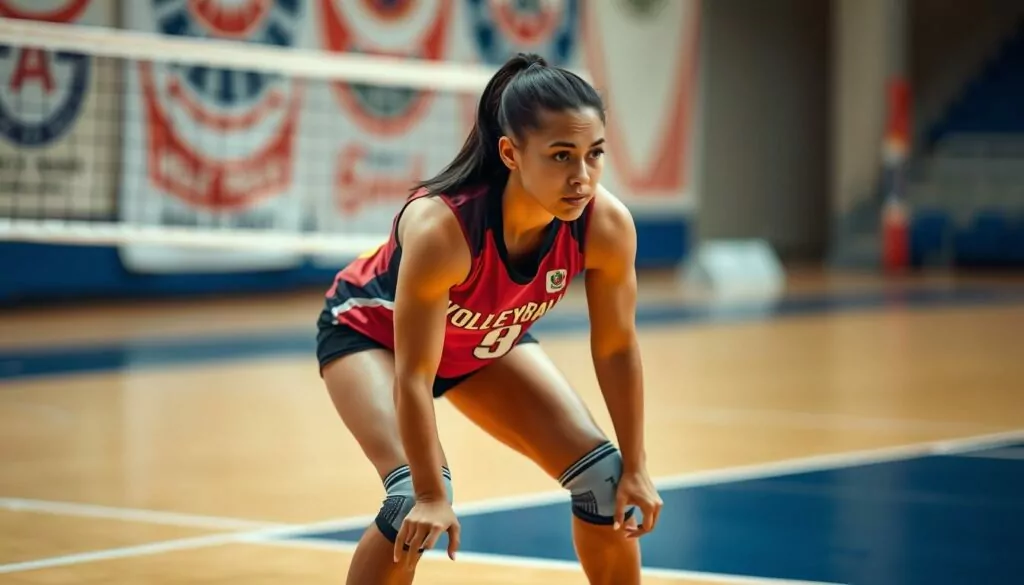
In volleyball, serve receive is key to starting the attack. It can change the game’s outcome. Good positioning and talking during serve receive are vital for success. This part talks about how serve receive can open up chances to score and mess up the opponent’s serve.
Why Serve Receive is Critical in Volleyball
The first touch by the receiving team, serve receive, sets the rally’s pace. A strong serve receive lets the team run their plays smoothly. But, a bad receive can make it hard to get back. Learning the right positions and doing volleyball warm-up exercises regularly are essential for a solid serve receive.
The Impact of Serve Receive on Game Dynamics
A good serve receive can upset the opponent’s serve plan, making them change their strategy. It lets the receiving team control the rally and find ways to score. On the other hand, a weak serve receive can let the server control the game’s pace.
| Drill | Description | Duration |
|---|---|---|
| Serve Receive Eye-Sequencing Progression | Focuses on cues from the server, with a gradual increase in complexity over three sessions. |
|
| Serve Receive Communication | Players practice communicating various aspects such as seams/zones, depth of the volleyball, location of the serve, and the passing player. | 20 minutes |
“Perfection in serve receive is nearly impossible to achieve, so it’s important to shift the focus to working on out-of-system balls.”
Effective serve receive is a key part of winning in volleyball. By improving player positioning and doing specific volleyball warm-up exercises, teams can upset their opponents’ serve and find more chances to score.
The Fundamentals of Serve Receive Technique
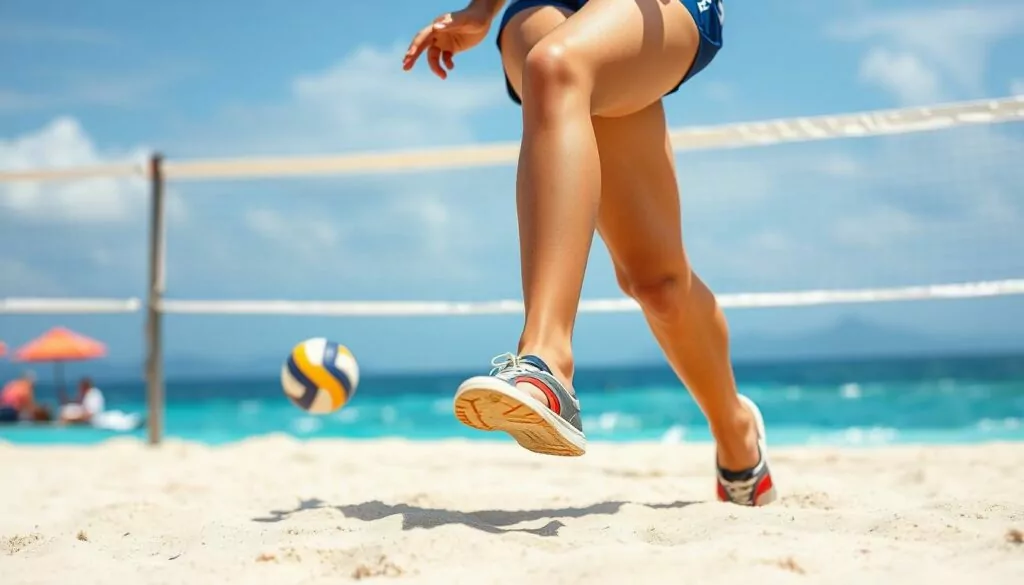
Learning serve receive is key for volleyball players. It involves the right body position and footwork. Knowing these basics can greatly improve your game.
Body Positioning for Effective Receives
Start with the right body position. Stand with your feet apart, knees bent, and weight balanced. This stance helps you quickly react to serves, whether they’re overhand or underhand.
Keep your torso straight, shoulders aligned, and eyes on the ball. This focus is important for a good receive.
Hand Placement and Contact Point
Having the right hand placement is essential. Hold your hands together, with fingers interlaced and elbows in. Make contact with the ball on your forearms, just below your wrists.
Apply gentle pressure as you receive the serve. This lets the ball bounce to the setter’s hands smoothly.
Footwork Essentials for a Better Receive
Good footwork is critical for receiving serves. Move a step or two towards the serve, using a quick, balanced step. Avoid big, uncontrolled steps that can disrupt your balance.
Stay light on your feet, ready to adjust your stance and move to the ball.
Mastering these techniques will make you a reliable and confident passer. This sets your team up for success in every game.
Types of Serves and How to Handle Them
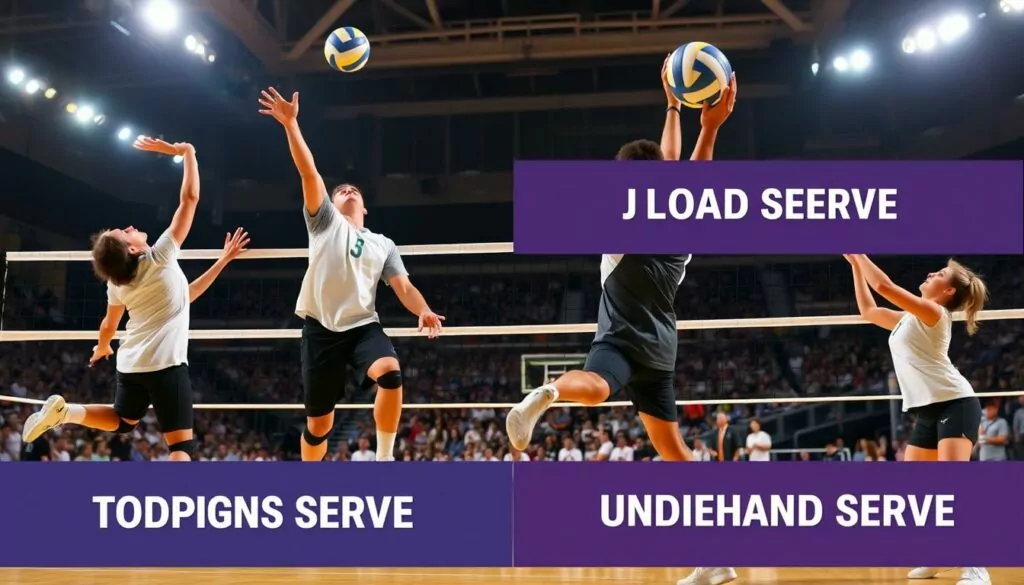
Volleyball is a dynamic sport with different serves needing unique strategies. From the unpredictable float serve to the powerful jump serve, knowing how to handle each is key. Let’s look at the main tips for managing various serve types and setting your team up for success.
Float Serves: Tips for Success
Float serves are hard to read because they move unpredictably. To receive a float serve well, keep your platform stable and watch the ball’s path. Anticipate its path and adjust your position as needed. Staying focused and calm is also important.
Topspin Serves: What to Expect
Topspin serves are fast and have a sharp angle. When receiving a topspin serve, move quickly and get under the ball. Use a solid platform to absorb the impact. Good footwork and hand positioning help provide a stable pass to your setter.
Jump Serves: Strategies to Counteract
The jump serve is a big challenge. Be ready to react fast, as the ball comes quickly and with spin. Keep an athletic stance and watch the ball until the end. Also, communicate with your teammates to get ready for the serve.
Mastering serve receive is vital for any volleyball team. Understanding different serve types and using the right strategies can greatly improve your team’s offense. Practice and paying attention to the ball’s movement are key to success.
Mental Preparation for Serve Receive
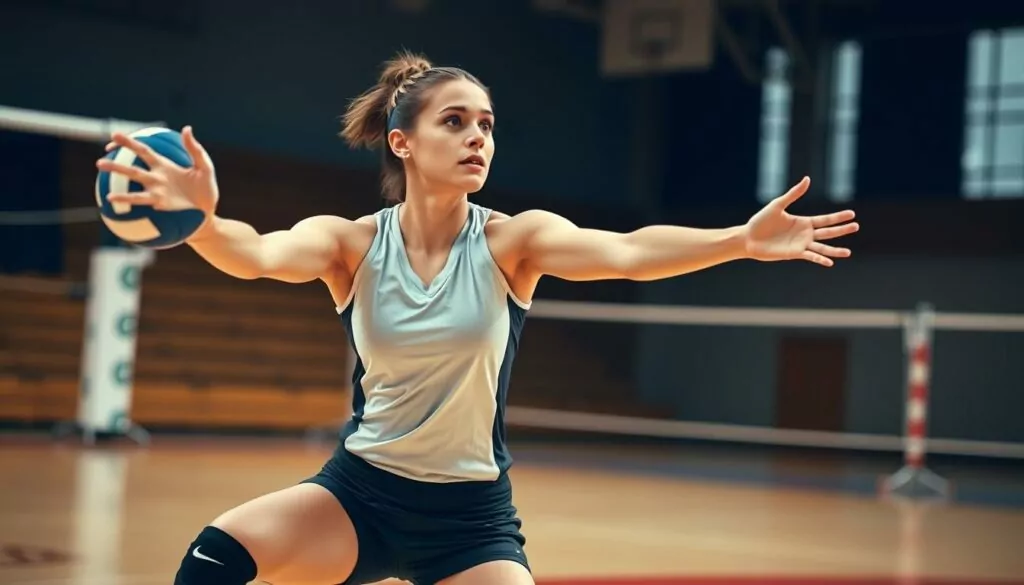
In volleyball, mental prep is as important as physical skills. I’ve learned to stay focused under pressure for serve receives. Visualization helps me see positive outcomes and boosts my game.
Staying Focused Under Pressure
Volleyball serve receive is intense and high-pressure. The ball’s pace, distance, and starting the play well are big challenges. A pre-serve routine keeps me focused, even with the pressure.
Visualization Techniques for Better Performance
Visualization has changed my game. It helps me mentally rehearse successful serves. This boosts my confidence and real-time skills.
Working with a mental coach or reading about mental toughness is key. It’s vital for volleyball players to improve their serve receive.
“The mental game is just as important as the physical game. Positive self-talk and visualization have been key to my success in serve receive.”
Staying focused and using visualization has made me a better serve receiver. These mental techniques have greatly improved my performance.
Communication with Teammates During Serve Receive
Good communication is key to a winning serve receive strategy. As volleyball players, we must work together to guess where the ball will go. Clear talk before and during the game helps us move as one unit.
Verbal Cues to Enhance Coordination
We use words like “Setter UP” and “Setter DOWN” to tell each other where to stand. During the game, saying “MINE” or “ON” helps us know who’s got the ball. We also cheer each other on with words like “Good swing.”
Understanding Each Player’s Role
New players might not know their spot on the court. This can cause problems if everyone doesn’t know who’s covering what. By teaching them clearly and encouraging them, we help everyone feel more confident and in sync.
| Verbal Cues for Serve Receive | Non-Verbal Cues for Serve Receive |
|---|---|
|
|
Using both words and body language, we can improve our teamwork. This helps us play better together.
Drills to Improve Serve Receive Skills
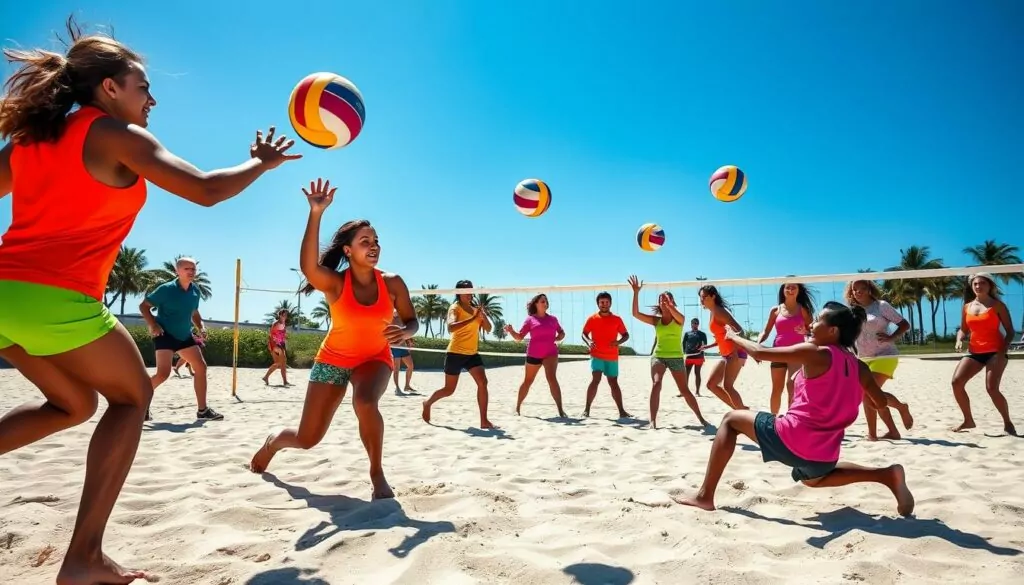
Being good at serve receive is key for volleyball success. There are many drills to improve your skills and boost your confidence. Let’s explore some drills to help you get better at volleyball passing.
Partner Drills for Consistent Practice
Practicing with a partner is great for improving serve receive. Try the 1-2 Serve & Pass drill. One player serves hard, and the other focuses on catching the ball well. This drill improves your teamwork, timing, and passing skills.
Solo Drills to Master Control
Even without a partner, solo drills can help a lot. The 8-Person Serve & Pass drill is good for this. It has many servers passing to one player. This drill enhances your control, positioning, and decision-making.
Game-Like Scenarios to Build Confidence
Training in game-like scenarios is essential. Drills like Winners, Speedball, and Player Winners mimic match pressure. They help you get better at passing under stress.
Adding these drills to your practice will make you a top player. You’ll master volleyball passing drills and dominate the court.
“The key to effective serve receive is consistent practice and a willingness to step out of your comfort zone. These drills will help you develop the skills and confidence you need to excel in this critical aspect of the game.”
Analyzing Opponent Serve Patterns
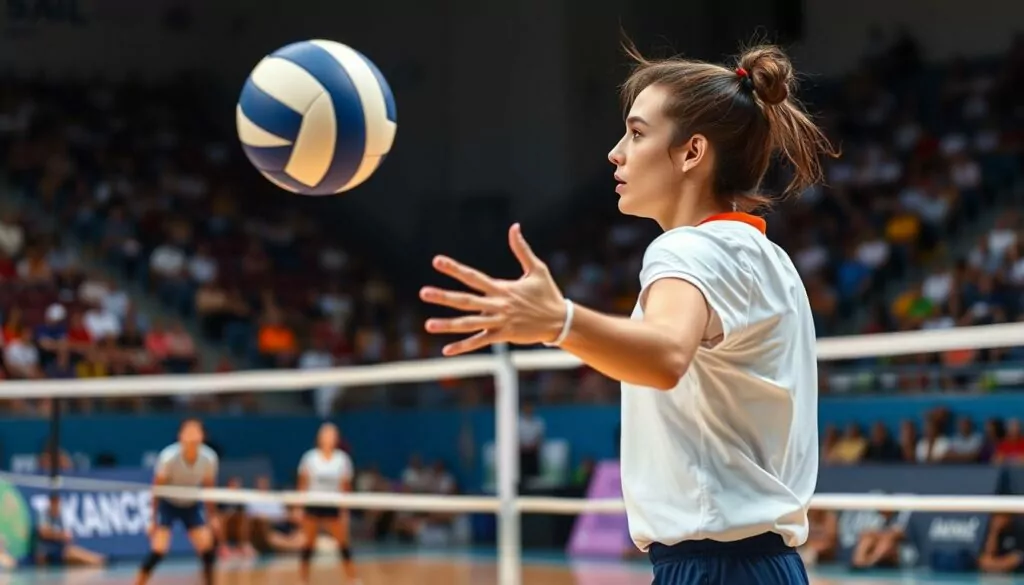
As a volleyball player, knowing your opponent’s serve patterns is key. It helps you prepare for their serves. This way, you can outsmart them and gain an edge on the court.
Recognizing Serving Tendencies
Watch your opponents closely during the game. Notice their serve types, speeds, and where they aim. Do they often use float, topspin, or jump serves? Do they usually aim for certain spots on the court? By understanding these patterns, you can guess their next move and get ready.
Adjusting My Position Based on Opponent Strategies
After spotting your opponent’s serve patterns, adjust your spot on the court. If they aim for a specific area, stand there to cover it better. If they vary their serves, be quick to move to different spots. This way, you boost your chances of catching their serves and starting a strong attack for your team.
| Serve Tendencies | Adjustments to My Position |
|---|---|
| Favors float serves to the corners | Move closer to the sidelines and be ready to quickly change direction |
| Mixes up topspin and jump serves | Stay light on my feet and be prepared to react quickly to the serve type |
| Frequently aims for the middle of the court | Position myself centrally and be ready to cover a wider area |
By studying your opponent’s serve patterns and adjusting your position, you can greatly enhance your serve receive skills. This gives your team a strategic advantage on the court.
Building Confidence in Serve Receive
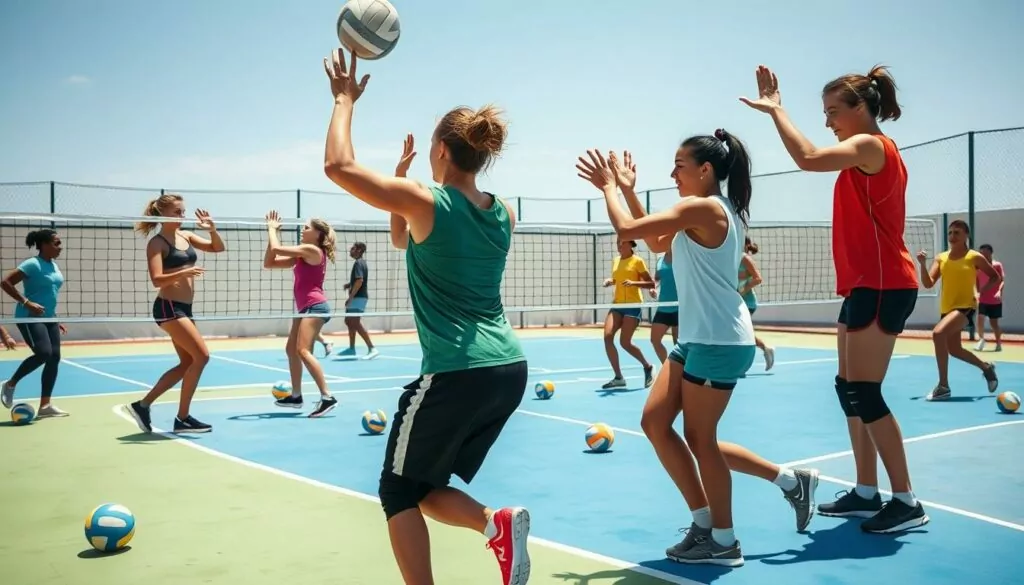
Confidence is key for good serve receive in volleyball. Without it, players can feel anxious and struggle to pass the ball well. To build confidence, it helps to use positive self-talk and celebrate small victories.
Positive Self-Talk Techniques
Positive self-talk is a powerful tool for confidence. Encouraging athletes to replace negative thoughts with positive can change their mindset. By focusing on their strengths, players can feel more confident and ready for serve receive.
Celebrating Small Wins to Boost Morale
It’s important to celebrate every small victory in volleyball. Recognizing a good pass or a successful serve receive can boost confidence and motivation. This positive feedback helps players stay motivated and focused, leading to better performances.
Building confidence in volleyball’s serve receive is a journey. By using positive self-talk and celebrating small wins, athletes can grow mentally strong. With confidence, volleyball players can reach their full abilities and improve their game.
Strategies for Different Playing Levels

Serving techniques and volleyball passing drills are key for all players. Whether you’re new or experienced, adjusting your approach can greatly improve your game. Let’s look at strategies for beginners and advanced players.
Tips for Beginners: Building a Strong Foundation
For newcomers, focus on a solid serve receive foundation. This means:
- Getting your body right, low and balanced, to catch the ball well.
- Working on consistent hand placement and contact to control the ball’s path.
- Learning good footwork to move smoothly and stay in position.
Beginners should do specific volleyball passing drills. This builds muscle memory and boosts confidence. Learning the basics is the first step to getting better.
Advanced Techniques for Experienced Players
For seasoned players, it’s about refining strategies and adapting to game situations. Advanced techniques include:
- Spotting and predicting different serves to adjust your play.
- Studying opponents’ serving patterns to position yourself better.
- Using advanced serves like short or targeted zone serves to upset the other team.
Advanced players should also work on mental prep, team communication, and using tech to improve their skills.
By matching your approach to your skill level, you can reach your full serve receive ability. This will help your team succeed on the court.
Adapting to Different Court Conditions
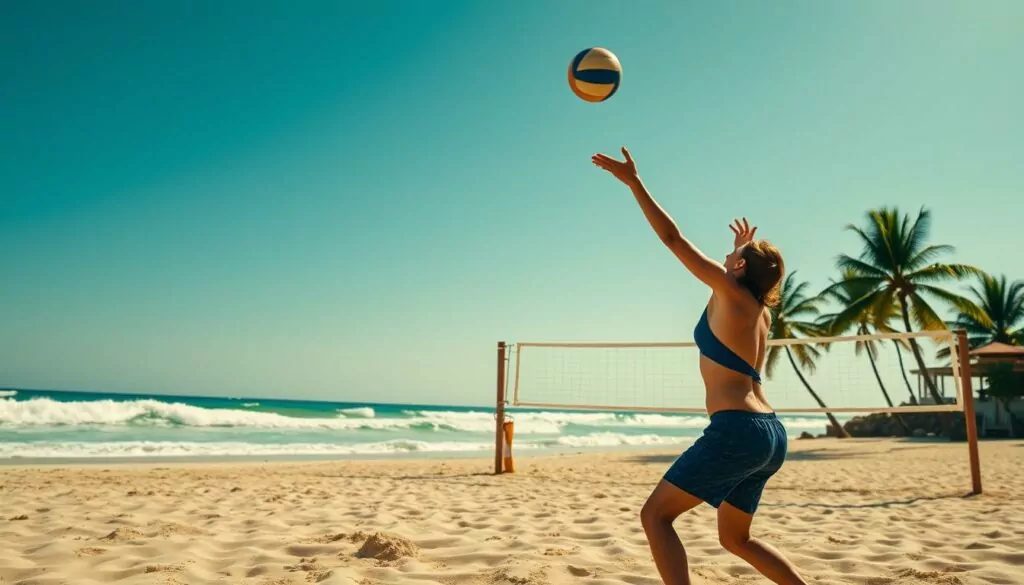
Playing beach or indoor volleyball means dealing with different court conditions. These conditions can greatly affect your serve receive technique. It’s key to adapt to these environments to do well on the court.
Indoor vs. Outdoor Considerations
Indoor courts offer a more stable setting, with consistent ball bounce and fewer external factors. Beach volleyball courts, on the other hand, are softer and more uneven. This can change how the ball moves and how you stand. To master beach volleyball serving, you need to adjust your approach to fit the court.
Weather Conditions that Affect Play
Outdoor volleyball, whether on the beach or in a park, adds extra challenges. Weather like wind, sun glare, and rain can alter the serve’s path and speed. It also makes it harder to track and pass the ball. Learning to handle indoor volleyball serving in various weather is key to being a versatile volleyball player.
| Court Condition | Key Considerations | Adaptation Strategies |
|---|---|---|
| Indoor Volleyball |
|
|
| Beach Volleyball |
|
|
| Outdoor Volleyball (General) |
|
|
Understanding the challenges of different courts and weather helps you develop the skills needed. This way, you can excel in both beach volleyball serving and indoor volleyball serving scenarios.
Utilizing Technology to Improve Serve Receive
Technology has changed the game of volleyball, making it easier to improve serve receive skills. Video analysis and apps are key tools that help players enhance their performance. They can take their game to new levels with these technologies.
Video Analysis for Skill Enhancement
Video analysis is a powerful tool for improving serve receive. Players can record their serves and receives to see their technique. This helps them spot areas to improve and make specific changes.
By examining their body positioning and footwork, players can become more consistent. This is how top teams like the University of Nebraska and Rutgers University use technology to get better.
Apps for Tracking Progress and Performance
Apps are also great for tracking serve receive performance. They let players log their stats and set goals. This way, they can see how they’re improving over time.
Apps give athletes a chance to understand their skills better. They help players adjust their training based on their data. This is what coaches like Greg Piteo and Jason Pullara use to improve their teams.
Technology is a game-changer for volleyball players. It helps them make better decisions and improve their skills. Whether it’s through video analysis or apps, technology is essential in today’s volleyball.
Importance of Recovery and Reflection
As a volleyball player, recovery and reflection are key to improving your serve receive skills. After each game or practice, taking time to analyze your performance can change the game. By knowing what worked and what didn’t, you can refine your technique and stay consistent.
Post-Game Analysis: What Went Right and Wrong
Doing a deep dive into your game is very valuable. Start by thinking about what went well in your serve receive. What strategies were successful, and how can you use them more? Then, look at what didn’t go so well. Were there mistakes or technical issues that held you back? By fixing these, you can make a plan to get better.
Techniques for Physical and Mental Recovery
Recovery is not just about your body; it’s also about your mind and emotions. Use different methods to help your recovery:
- Do light, active recovery like stretching or easy cardio to help muscles heal.
- Try relaxation techniques like deep breathing or meditation to calm your mind and body.
- Eat right and drink plenty of water to help your body repair and recharge.
- Make sure to get enough rest and sleep to let your body and mind recover.
By focusing on both physical and mental recovery, you’ll be ready to keep up with your volleyball warm-up exercises and play your best.
Remember, mastering serve receive is a journey. Embrace recovery and reflection, and you’ll see your volleyball career soar.
Maintaining Physical Fitness for Serve Receive
Being a volleyball player means you need to stay fit. You need strength, agility, and flexibility to move fast and confidently. Adding specific exercises to your routine can boost your serve receive skills.
Strength Training to Enhance Performance
Strength training is key for serve receive success. It builds muscle power and stability. Focus on your core, legs, and upper body with exercises like squats, deadlifts, push-ups, and bench presses.
- Squats and deadlifts to develop lower-body strength
- Push-ups and bench presses to strengthen the upper body
- Planks and core-focused exercises to improve core stability
Agility and Flexibility Exercises
Agility and flexibility are vital for volleyball. Agility drills and flexibility exercises help you move better. This lets you react fast and maintain good form during serves and returns.
- Lateral shuffles and zig-zag drills to improve agility
- Dynamic stretching routines to enhance range of motion
- Plyometric exercises, such as box jumps, to build explosive power
A balanced fitness routine that includes strength, agility, and flexibility is essential. It will improve your serve receive skills. Stay committed to your training to excel in volleyball.
| Exercise | Benefits | Targeted Muscle Groups |
|---|---|---|
| Squats | Improved lower-body strength, power, and stability | Quadriceps, hamstrings, glutes |
| Push-ups | Stronger upper-body and core muscles for better serve receive | Chest, shoulders, triceps, core |
| Lateral Shuffles | Enhanced agility and quick lateral movements | Leg muscles, core |
| Dynamic Stretching | Improved range of motion and flexibility for better court coverage | Muscles throughout the body |
Joining a Volleyball Community for Continuous Improvement
Being part of a vibrant volleyball community has really helped me improve my serve receive skills. I’ve joined local clubs and leagues where I practice often. I also get to play against different opponents and get feedback from coaches and players.
Finding Local Clubs or Leagues
Looking for local volleyball clubs or leagues changed the game for me. These groups offer a supportive place to work on my passing drills. I get help from coaches and learn a lot about the game and teamwork.
Benefits of Participating in Camps and Clinics
Attending volleyball camps and clinics has also been a big plus. These sessions let me get one-on-one coaching and feedback on my technique. It’s a focused way to learn and improve, helping me get better at volleyball.
